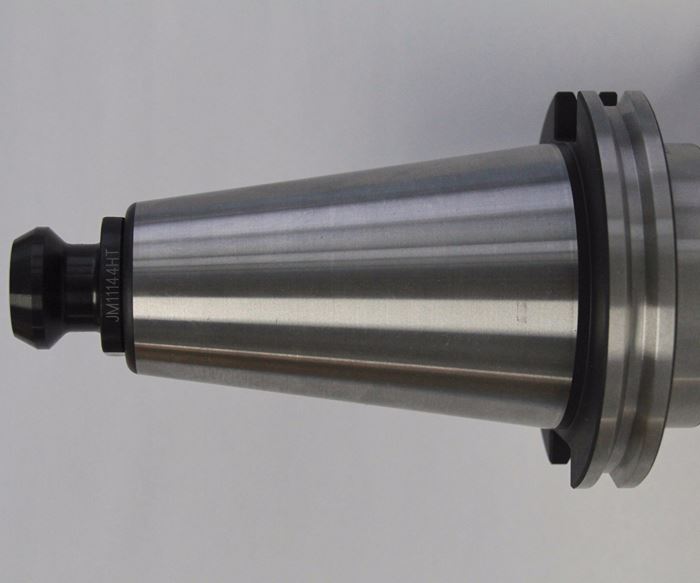What If a Small Investment Could Increase Your Milling Productivity?
Improper seating of tapered toolholders in the spindle is often overlooked when evaluating a milling machine’s performance and efficiency. Today, there is an inexpensive fix for this design flaw a former President at Toyota Motor Manufacturing wants to share.
This case study from JM Performance Products, Inc. shares the success of an inexpensive fix for a flaw in the design and use of retention knobs in tapered toolholders secured by drawbars.
Joe DaRosa, former president at Toyota Motor Manufacturing, Texas, Inc. says that companies purchase top-of-the-line machining centers and expensive cutting tools, yet they completely ignore the toolholder and retention knob. This interface can have a design flaw causing improper seating of tapered toolholders in the spindle, which affects the performance and efficiency of a CNC milling machine.
DaRosa is referring to a flaw in the design and utilization of retention knobs in tapered toolholders secured by drawbars, such as the popular V-flange, that date back to the original designs first introduced decades ago.
When DeRosa first learned about an inexpensive fix to a machining problem that even by conservative estimates could increase productivity 15 percent and tool life even more, he was immediately intrigued.
“If you’re an executive, you’re going to look at this [solution] and see reduced costs and increased productivity, and if you are a machining operator you will see increased tool life and less changeover frequency,” DaRosa says.
The flaw. Although the shank of tapered toolholders is ground to a fine finish to fit in the spindle within very precise, established tolerances, those that use drawbars are also threaded at the narrow end to accept a retention knob. The knob is designed to engage with the drawbar, which exerts a pull force that holds the toolholder firmly in the spindle.
The problem is poorly designed, traditional retention knobs (a less than $20 part) when tightened, create a bulge in the taper that prevents full contact and proper seating in the spindle. Once this expansion occurs, the toolholder will not pull fully into the spindle and cannot make contact with 70 percent of its surface.
Perhaps because the shank and spindle are so carefully machined or because the industry has utilized retention knobs on tapered products for decades, this issue has largely been overlooked.
However, the results are manifested in a wide range of CNC milling issues often attributed to other causes. For example, vibration and chatter, poor tolerances, non- repeatability, poor finishes, shortened tool life, excessive spindle wear and tear, run-out, and shallow depths of cuts.
High-torque retention knobs. In 2009, JM Performance Products, Inc. (JMPP) introduced its high-torque retention knob. Invented by the company’s founder, John Stoneback, the product works with all existing toolholders including BT, DIN, ISO, and CAT toolholders from 30 taper to 60 taper.
This retention knob is longer, by design, to reach deeper into the threaded bore of the toolholder. As a result, all thread engagement occurs in a region of the toolholder where there is a thicker cross-section of material to resist deformation.
It also includes a precision pilot to increase rigidity, and is balanced by design. Since even over-tightening of the high-torque retention knobs can still create a bulge, the company provides specifically calculated torque specs based on drawbar pressure.
By combining the high-torque retention knob with the correct torque, spindle contact with the taper is improved to close to 100 percent every time. This can be verified by a simple six-step “touch off” test (www.jmperformanceproducts.com/toolholder-test.aspx). More sophisticated measurement of toolholder expansion (bulge) can also be taken using a taper shank test fixture.
Although the product costs nominally more than a traditional retention knob, at a conservative 10-percent increase in productivity, the ROI can be as little as 3 weeks, according to JMPP.
Related Content
Machine Hammer Peening Automates Mold Polishing
A polishing automation solution eliminates hand work, accelerates milling operations and controls surface geometries.
Read MoreLeading Mold Manufacturers Share Best Practices for Improving Efficiency
Precise Tooling Solutions, X-Cell Tool and Mold, M&M Tool and Mold, Ameritech Die & Mold, and Cavalier Tool & Manufacturing, sit down for a fast-paced Q&A focused on strategies for improving efficiencies across their operations.
Read MoreMaking Quick and Easy Kaizen Work for Your Shop
Within each person is unlimited creative potential to improve shop operations.
Read MoreICYMI: MMT Chats: True Leadership Leads to Mentoring, Part 1
This trio from TK Mold and Engineering in Romeo, Michigan, joins me to discuss the role of leadership and culture in mentorship. This episode is brought to you by ISCAR with New Ideas for Machining Intelligently.
Read MoreRead Next
Are You a Moldmaker Considering 3D Printing? Consider the 3D Printing Workshop at NPE2024
Presentations will cover 3D printing for mold tooling, material innovation, product development, bridge production and full-scale, high-volume additive manufacturing.
Read MoreReasons to Use Fiber Lasers for Mold Cleaning
Fiber lasers offer a simplicity, speed, control and portability, minimizing mold cleaning risks.
Read MoreHow to Use Strategic Planning Tools, Data to Manage the Human Side of Business
Q&A with Marion Wells, MMT EAB member and founder of Human Asset Management.
Read More









_300x250 1.png;maxWidth=300;quality=90)

.jpg;maxWidth=300;quality=90)
















.jpg;maxWidth=970;quality=90)